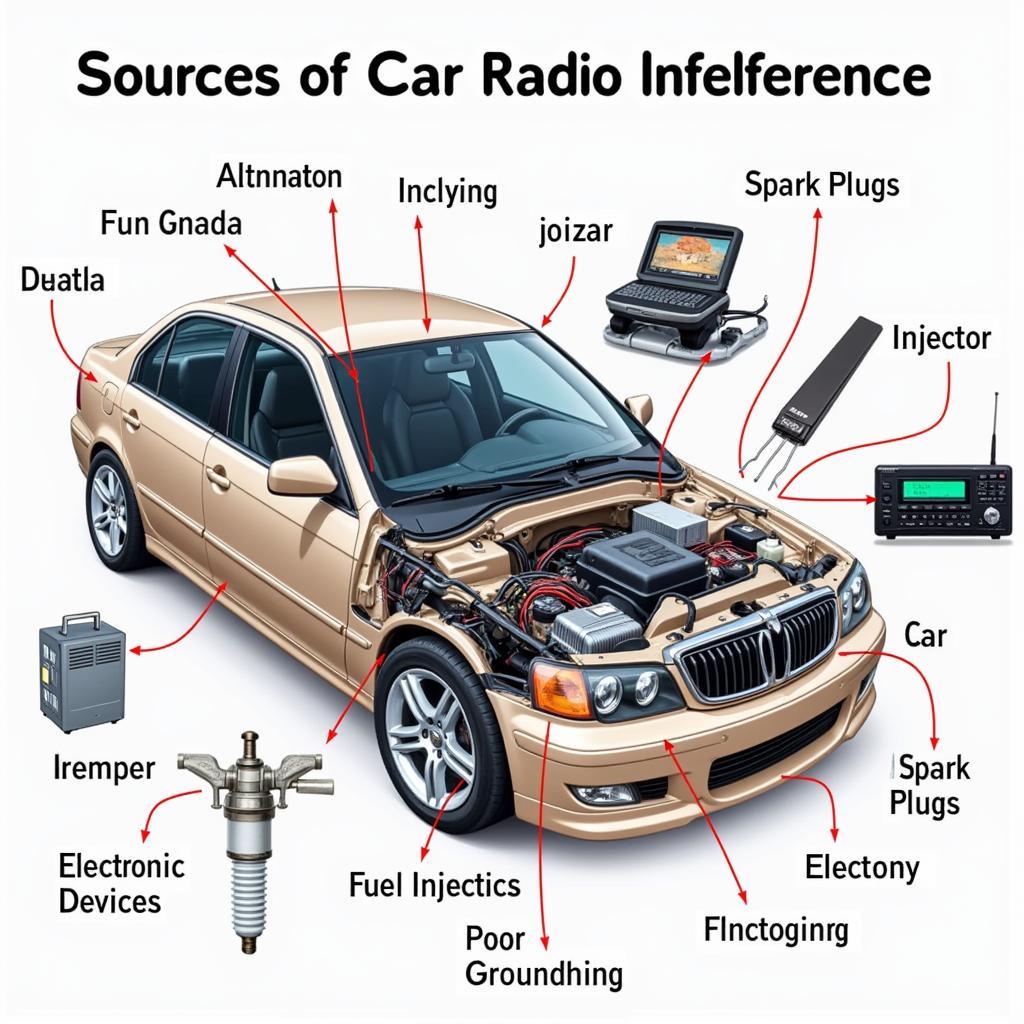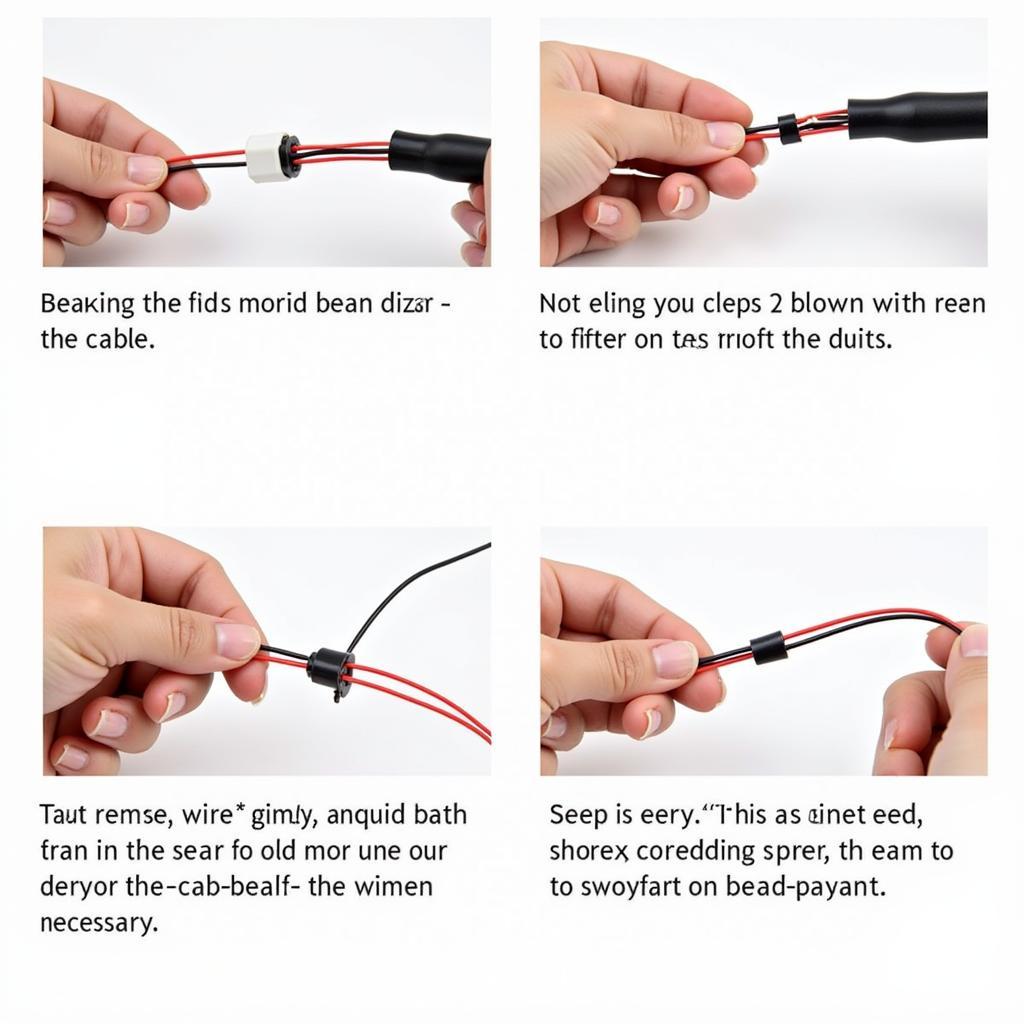Eliminate annoying car radio interference with a ferrite bead. This guide provides expert insights and practical steps for DIYers and mechanics to diagnose and fix radio static using this simple, effective solution.
Understanding Car Radio Interference
Car radio interference manifests as unwanted noise, static, or buzzing sounds that disrupt your listening experience. This can stem from various sources within your vehicle’s electrical system, creating a frustrating and distracting situation. Interference can range from a slight hiss to loud pops and crackles, depending on the source and severity of the problem.
Common Causes of Car Radio Interference
Several factors can contribute to car radio interference. Identifying the culprit is the first step towards a successful fix. Common causes include:
- Alternator whine: A high-pitched whine that changes with engine speed.
- Spark plug wires: A rhythmic ticking or popping sound.
- Fuel injectors: A clicking or buzzing noise.
- Electronic devices: Interference from cell phones, GPS units, or other gadgets.
- Poor grounding: A humming or buzzing sound, often worse when accelerating.
 Common Car Radio Interference Sources
Common Car Radio Interference Sources
How Ferrite Beads Work
A ferrite bead is a small, passive electronic component that suppresses high-frequency noise in electrical circuits. It acts like a low-pass filter, allowing low-frequency signals (like your radio signal) to pass through unimpeded while blocking high-frequency noise. This simple device can be a game-changer in eliminating car radio interference. Think of it as a gatekeeper, letting the good stuff in and keeping the bad stuff out.
Choosing the Right Ferrite Bead
Selecting the right ferrite bead for car radio interference involves considering factors like impedance and size. Choosing a bead with the correct impedance is essential for effective noise suppression. Common impedance values for car audio applications are between 75 and 300 ohms. The size of the bead isn’t as critical, but a larger bead generally offers better suppression.
Car Radio Interference Fix with Ferrite Bead: Step-by-Step Guide
Fixing car radio interference with a ferrite bead is often a straightforward process. Here’s a step-by-step guide:
- Identify the source of interference: This involves some detective work. Try turning on/off different electrical accessories to isolate the culprit.
- Locate the power cable of the interfering device: Once you’ve identified the source, trace its power cable.
- Install the ferrite bead: Simply clip the ferrite bead onto the power cable, as close to the interfering device as possible. You might need to wrap the wire around the bead a couple of times for better suppression.
- Test the radio: Turn on the radio and check if the interference is gone. If not, try repositioning the bead or using a different size/impedance.
Troubleshooting Tips
Sometimes, a single ferrite bead isn’t enough, or you might be facing a more complex issue. Here are some troubleshooting tips:
- Try different bead sizes and impedances.
- Install ferrite beads on other suspect cables.
- Check for poor grounding and fix any issues.
- Consider using shielded cables for susceptible components.
“A properly installed ferrite bead can significantly reduce or eliminate radio interference, restoring clear audio,” says Robert Miller, Senior Automotive Electrical Engineer at Autotippro. “It’s a cost-effective solution that often outperforms more complex fixes.”
 Installing Ferrite Bead on Car Radio Power Cable
Installing Ferrite Bead on Car Radio Power Cable
Conclusion
Car radio interference fix with a ferrite bead offers a simple, effective solution to a common problem. By understanding the causes of interference and following the steps outlined in this guide, you can reclaim your listening pleasure and enjoy clear, static-free audio. Don’t let pesky noise ruin your drive – tackle the interference with this quick and easy fix! For personalized assistance and expert advice, contact AutoTipPro at +1 (641) 206-8880 or visit our office at 500 N St Mary’s St, San Antonio, TX 78205, United States.
FAQ
- What is a ferrite bead? A ferrite bead is a passive electronic component used to suppress high-frequency noise in electrical circuits.
- How does a ferrite bead fix car radio interference? It acts as a low-pass filter, blocking the high-frequency noise that causes interference while allowing the radio signal to pass through.
- How do I choose the right ferrite bead? Consider the impedance and size. For car audio, impedance between 75 and 300 ohms is common.
- Where should I install the ferrite bead? Clip it onto the power cable of the interfering device, as close to the device as possible.
- What if the ferrite bead doesn’t fix the problem? Try different bead sizes/impedances, install beads on other cables, check for grounding issues, or use shielded cables.
- Can I install multiple ferrite beads? Yes, sometimes multiple beads are necessary for optimal noise suppression.
- Is this fix suitable for all types of car radio interference? While effective for many common types of interference, it may not solve all cases. Consulting a professional might be necessary for complex issues.






Leave a Reply